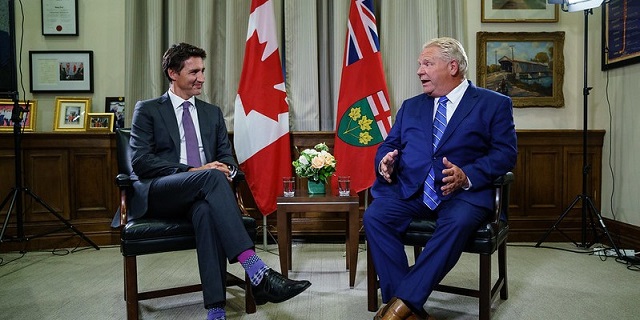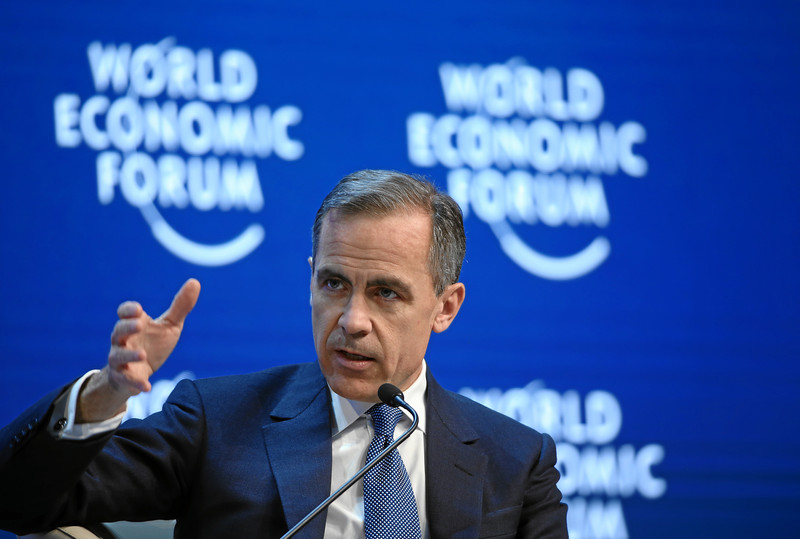Business
Honda deal latest episode of corporate welfare in Ontario

From the Fraser Institute
By Jake Fuss and Tegan Hill
If Honda, Volkswagen and Stellantis are unwilling to build their EV battery plants in Ontario without corporate welfare, that sends a strong signal that those projects make little economic sense.
On Thursday, the Trudeau and Ford governments announced they will dole out an estimated $5 billion in corporate welfare to Honda so the auto giant can build an electric vehicle (EV) battery plant and manufacture EVs in Ontario. This is the third such deal in Ontario, following similar corporate welfare handouts to Volkswagen ($13.2 billion) and Stellantis ($15.0 billion). Like the previous two deals, the Honda deal comes at a significant cost to taxpayers and will almost certainly fail to create widespread economic benefits for Ontarians.
The Trudeau and Ford governments finalized the Honda deal after more than a year of negotiations, with both governments promising direct incentives and tax credits. Of course, this isn’t free money. Taxpayers in Ontario and the rest of Canada will pay for this corporate welfare through their taxes.
Unfortunately, corporate welfare is nothing new. Governments in Canada have a long history of picking their favoured firms or industries and using a wide range of subsidies and other incentives to benefit those firms or industries selected for preferential treatment.
According to a recent study, the federal government spent $84.6 billion (adjusted for inflation) on business subsidies from 2007 to 2019 (the last pre-COVID year). Over the same period, provincial and local governments spent another $302.9 billion on business subsidies for their favoured firms and industries. (Notably, the study excludes other forms of government support such as loan guarantees, direct investments and regulatory privileges, so the total cost of corporate welfare during this period is actually much higher.)
Of course, when announcing the Honda deal, the Trudeau and Ford governments attempted to sell this latest example of corporate welfare as a way to create jobs. In reality, however, there’s little to no empirical evidence that corporate welfare creates jobs (on net) or produces widespread economic benefits.
Instead, these governments are simply picking winners and losers, shifting jobs and investment away from other firms and industries and circumventing the preferences of consumers and investors. If Honda, Volkswagen and Stellantis are unwilling to build their EV battery plants in Ontario without corporate welfare, that sends a strong signal that those projects make little economic sense.
Unfortunately, the Trudeau and Ford governments believe they know better than investors and entrepreneurs, so they’re using taxpayer money to allocate scarce resources—including labour—to their favoured projects and industries. Again, corporate welfare actually hinders economic growth, which Ontario and Canada desperately need, and often fails to produce jobs that would not otherwise have been created, while also requiring financial support from taxpayers.
It’s only a matter of time before other automakers ask for similar handouts from Ontario and the federal government. Indeed, after Volkswagen secured billions in federal subsidies, Stellantis stopped construction of an EV battery plant in Windsor until it received similar subsidies from the Trudeau government. Call it copycat corporate welfare.
Government handouts to corporations do not pave the path to economic success in Canada. To help foster widespread prosperity, governments should help create an environment where all businesses can succeed, rather than picking winners and losers on the backs of taxpayers.
Authors:
Automotive
Tesla Vandals Keep Running Into The Same Problem … Cameras


From the Daily Caller News Foundation
By Hudson Crozier
People damaging Teslas in anger toward their owners and Elon Musk aren’t picking up on the fact that the vehicles have multiple cameras capable of catching them in the act.
At least nine perpetrators have been caught on video keying, writing graffiti or otherwise defacing Tesla vehicles in parking lots across the U.S. in the month of March alone. Most have led to an arrest or warrant based partly on the footage, which Tesla’s “Sentry Mode” automatically films from the side of the unattended vehicle when it detects human activity nearby.
“Smile, you’re on camera,” Tesla warned in a March 20 X post about its Sentry Mode feature. Musk’s company has been working to upgrade Sentry Mode so that the vehicles will soon blast music at full volume when vandals attack it. The camera system, however, has not stopped an increasing number of vandals from singling out Tesla owners, usually in protest of Musk’s work in the Trump administration for the Department of Government Efficiency (DOGE).
One incident happened on March 29, the same day leftists coordinated protests around the country for a “Global Day of Action” against Musk. That Saturday also saw alleged instances of violence at protests. The demonstrations stemmed from an online call to action by groups such as the Disruption Project, which encourages activists to foment “uprisings,” find a “target’s” home address and other confrontational tactics.
Tesla’s press team did not respond to a request for comment.
One man allegedly caught on camera keying a Tesla SUV on March 24 apologized to the owner who confronted him in a parking lot in Pennsylvania, police and media reports said. The man faces charges of criminal mischief, harassment and disorderly conduct for allegedly carving a swastika onto the vehicle.
“I have nothing against your car, and I have nothing against you,” the suspect said while the owner filmed him in the parking lot. “Obviously, I have something against Elon Musk.” The man called his own behavior “misguided.”
The defendant’s lawyer told Fox News his “client is a proud father, long-time resident, and is currently undergoing cancer treatment” and that he would not comment publicly “pending the outcome of the case.”
One of the most aggressive acts caught by Sentry Mode was in the case of a man who drove an ATV-style vehicle into a Tesla on March 25. Texas police identified the man as Demarqeyun Marquize Cox, arrested him and said he allegedly gave two other nearby Teslas the same treatment while also writing “Elon” on them. The public defender office representing Cox did not respond to a voicemail from the Daily Caller News Foundation.
Tesla cameras also caught three other people in Florida, Texas and Arizona keying and smearing bubble gum on the vehicles in March. The three suspects named by police do not have attorneys listed in county records available for contact.
Many of the vandalism cases since Trump’s return have reportedly caused thousands of dollars in damage for individual owners. For example, the bubble gum incident in Florida brought $2,623.66 in costs, while another keying incident in Minnesota brought $3,200.
Some reported attacks on Tesla vehicles and chargers have gotten the attention of federal law enforcement, including cases of alleged firebombing or shooting.
Two other suspected vandals in New York, one in Minnesota and one in Mississippi have reportedly avoided arrest for now — with one owner declining to press charges — but were all seen on the Teslas’ cameras scratching up the vehicles. Police identified the Mississippi suspect as an illegal migrant from Cuba.
One Tesla owner in North Dakota ridiculed a man who allegedly carved the letter “F” into his Cybertruck in a Costco parking lot — as seen on the Cybertruck’s camera. The defendant faces charges of criminal mischief, and county records say he is representing himself in court.
“I can’t believe this guy is potentially ruining his life to follow a political ideology,” the owner told WDAY News.
“If you’re going to vandalize these vehicles, you’re going to get caught,” the owner said.
Carbon Tax
The book the carbon taxers don’t want you to read

By Franco Terrazzano
Prime Minister Mark Carney wrote a 500-page book praising carbon taxes.
Well, I just wrote a book smashing through the government’s carbon tax propaganda.
It tells the inside story of the fight against the carbon tax. And it’s THE book the carbon taxers don’t want you to read.
My book is called Axing the Tax: The Rise and Fall of Canada’s Carbon Tax.
Axing the Tax: The Rise and Fall of Canada’s Carbon Tax
Every now and then, the underdog wins one.
And it looks like that’s happening in the fight against the carbon tax.
It’s not over yet, but support for the carbon tax is crumbling. Some politicians vow to scrap it. Others hide behind vague plans to repackage it. But virtually everyone recognizes support for the current carbon tax has collapsed.
It wasn’t always this way.
For about a decade now, powerful politicians, government bureaucrats, academics, media elites and even big business have been pushing carbon taxes on the people.
But most of the time, politicians never asked the people if they supported carbon taxes. In other words, carbon taxes, and the resulting higher gas prices and heating bills, were forced on us.
We were told it was good for us. We were told carbon taxes were inevitable. We were told politicians couldn’t win elections without carbon taxes, even though the politicians that imposed them didn’t openly run on them. We were told that we needed to pay carbon taxes if we wanted to leave a healthy environment for our kids and grandkids. We were told we needed to pay carbon taxes if we wanted to be respected in the international community.
In this decade-long fight, it would have been understandable if the people had given up and given in to these claims. It would have been easier to accept what the elites wanted and just pay the damn bill. But against all odds, ordinary Canadians didn’t give up.
Canadians knew you could care about the environment and oppose carbon taxes. Canadians saw what they were paying at the gas station and on their heating bills, and they knew they were worse off, regardless of how many politicians, bureaucrats, journalists and academics tried to convince them otherwise. Canadians didn’t need advanced degrees in economics, climate science or politics to understand they were being sold a false bill of goods.
Making it more expensive for a mom in Port Hope to get to work, or grandparents in Toronto to pay their heating bill, or a student in Coquitlam to afford food won’t reduce emissions in China, Russia, India or the United States. It just leaves these Canadians, and many like them, with less money to afford everything else.
Ordinary Canadians understood carbon taxes amount to little more than a way for governments to take more money from us and dictate how we should live our lives. Ordinary Canadians also saw through the unfairness of the carbon tax.
Many of the elites pushing the carbon tax—the media, politicians, taxpayer-funded professors, laptop activists and corporate lobbyists—were well off and wouldn’t feel the brunt of carbon taxes. After all, living in a downtown condo and clamouring for higher carbon taxes doesn’t require much gas, diesel or propane.
But running a business, working in a shop, getting kids to soccer and growing food on the farm does. These are the Canadians the political class forgot about when pushing carbon taxes. These are the Canadians who never gave up. These are the Canadians who took time out of their busy lives to sign petitions, organize and attend rallies, share posts on social media, email politicians and hand out bumper stickers.
Because of these Canadians, the carbon tax could soon be swept onto the ash heap of history. I wrote this book for two reasons.
The first is because these ordinary Canadians deserve it. They worked really hard for a really long time against the odds. When all the power brokers in government told them, “Do what we say—or pay,” they didn’t give up. They deserve to know the time and effort they spent fighting the carbon tax mattered. They deserve all the credit.
Thank you for everything you did.
The second reason I wrote this book is so people know the real story of the carbon tax. The carbon tax was bad from the start and we fought it from the start. By reading this book, you will get the real story about the carbon tax, a story you won’t find anywhere else.
This book is important because if the federal Liberals’ carbon tax is killed, the carbon taxers will try to lay blame for their defeat on Prime Minister Justin Trudeau. They will try to say that carbon taxes are a good idea, but Trudeau bungled the policy or wasn’t a good enough salesman. They will try to revive the carbon tax and once again make you pay more for gas, groceries, and home heating.
Just like with any failed five-year plan, there is a lingering whiff among the laptop class and the taxpayer-funded desk rulers that this was all a communication problem, that the ideal carbon tax hasn’t been tried yet. I can smell it outside my office building in Ottawa, where I write these words. We can’t let those embers smoulder and start a fire again.
This book shows why the carbon tax is and always will be bad policy for ordinary Canadians.
Franco’s note: You can pre-order a copy of my new book, Axing the Tax: The Rise and Fall of Canada’s Carbon Tax, here: https://www.amazon.ca/Axing-
-

 2025 Federal Election17 hours ago
2025 Federal Election17 hours agoMark Carney refuses to clarify 2022 remarks accusing the Freedom Convoy of ‘sedition’
-

 2025 Federal Election21 hours ago
2025 Federal Election21 hours agoPoilievre To Create ‘Canada First’ National Energy Corridor
-

 Bruce Dowbiggin19 hours ago
Bruce Dowbiggin19 hours agoAre the Jays Signing Or Declining? Only Vladdy & Bo Know For Sure
-

 2025 Federal Election20 hours ago
2025 Federal Election20 hours agoFixing Canada’s immigration system should be next government’s top priority
-

 Daily Caller18 hours ago
Daily Caller18 hours agoBiden Administration Was Secretly More Involved In Ukraine Than It Let On, Investigation Reveals
-

 2025 Federal Election2 days ago
2025 Federal Election2 days agoCanada Continues to Miss LNG Opportunities: Why the World Needs Our LNG – and We’re Not Ready
-

 Health2 days ago
Health2 days agoSelective reporting on measles outbreaks is a globalist smear campaign against Trump administration.
-

 2025 Federal Election2 days ago
2025 Federal Election2 days agoMark Carney is trying to market globalism as a ‘Canadian value.’ Will it work?




